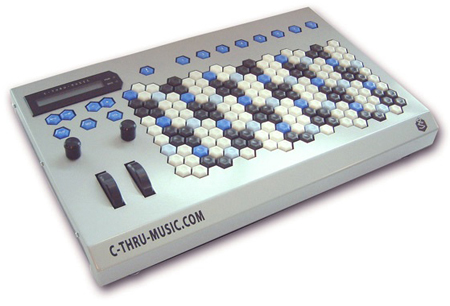I've just heard the devastating news, that one of my all time favorite artists - Gianluigi Gasparetti - aka - Oöphoi - has passed away after a long period of illness.
For visitors unfamiliar with the music of Oöphoi, he was a prolific creator of many exquisitely beautiful albums and was among the towering figures in the Italian ambient/soundscape scene.
So many perfectly beautiful compositions...
He will be sorely missed for his rare sonic vision and vast contribution to the audio arts. From a personal perspective, what makes his catalog such a treasure for the future, is its ability to endure repeated listenings down through the years, and every time I return to his albums, they remain fresh to my ears and reveal ever greater depths of detail on each new hearing. As anyone can that composes music can relate to, it is extremely difficult to attain this kind of quality, but it is a thread consistently woven throughout the fabric of his vast discography.
Speechless right now and will be listening shortly to one of my favorite Oöphoi albums: Hymns To A Silent Sky (2005).
Oöphoi - Fragile Beauty
This entire album is wonderful and I've always loved the long-form composition The Unbearable Sadness Of Memories...
Oöphoi - The Unbearable Sadness Of Memories (Hymns To A Silent Sky)
I have personally long regarded this as a composition of perfected beauty among many, many others by Oöphoi.
More Oöphoi on YouTube
Just intonation composer, Robert Rich, has a nice dedication on his site:
For Gianluigi Gasparetti, “Oöphoi”
Hypnos label owner, Mike Griffin has a tribute here:
Oöphoi (Gianluigi Gasparetti) Has Passed Away
An Oöphoi Wikipedia article and discography:
Oöphoi
Update: 2013-04-19
For what it may be worth, in celebration of the life and creative work of this wonderful artist, this past week I've returned to my private Oöphoi archive with new ears, and renewed interest, to do more Deep Listenings of the following timeless and amazingly beautiful records:
Oöphoi - Static Soundscapes - Three Lights at the End of the World (Hic Sunt Leones, 1996)
Oöphoi - The Spirals of Time (Limited Deluxe Edition - 1998)
Oöphoi - Mare Vaporum (2000)
Oöphoi - Athlit (2002)
Oöphoi - Bardo (2002)
Oöphoi - Mare Imbrium (2003)
Oöphoi - Mare Tranquilitatis (2004)
Oöphoi - The Dreaming Of Shells (2004)
Oöphoi & Tau Ceti - Archaic Oceans (2004)
Oöphoi - Hymns to a Silent Sky (2005)
Oöphoi - Awakening The Nagas (Penumbra, 2005)
Oöphoi - The Rustling Of Leaves (2005)
Oöphoi - Time Fragments Vols. 1-6 (2001-2005)
Oöphoi & Tau Ceti - Celestial Geometries (The Complete Recordings - 2006)
Oöphoi - Dreams, Parts 1-3 (2006)
Oöphoi - Arpe Di Sabbia (2007)
Oöphoi & Faryus - Forgotten Rituals (2007)
These I would have to rank as among my top favorite Oöphoi records, although there are many more available to consider. Highly recommended if you have a way to obtain them.
For visitors unfamiliar with the music of Oöphoi, he was a prolific creator of many exquisitely beautiful albums and was among the towering figures in the Italian ambient/soundscape scene.
So many perfectly beautiful compositions...
He will be sorely missed for his rare sonic vision and vast contribution to the audio arts. From a personal perspective, what makes his catalog such a treasure for the future, is its ability to endure repeated listenings down through the years, and every time I return to his albums, they remain fresh to my ears and reveal ever greater depths of detail on each new hearing. As anyone can that composes music can relate to, it is extremely difficult to attain this kind of quality, but it is a thread consistently woven throughout the fabric of his vast discography.
Speechless right now and will be listening shortly to one of my favorite Oöphoi albums: Hymns To A Silent Sky (2005).
Oöphoi - Fragile Beauty
This entire album is wonderful and I've always loved the long-form composition The Unbearable Sadness Of Memories...
Oöphoi - The Unbearable Sadness Of Memories (Hymns To A Silent Sky)
I have personally long regarded this as a composition of perfected beauty among many, many others by Oöphoi.
More Oöphoi on YouTube
Just intonation composer, Robert Rich, has a nice dedication on his site:
For Gianluigi Gasparetti, “Oöphoi”
Hypnos label owner, Mike Griffin has a tribute here:
Oöphoi (Gianluigi Gasparetti) Has Passed Away
An Oöphoi Wikipedia article and discography:
Oöphoi
Update: 2013-04-19
For what it may be worth, in celebration of the life and creative work of this wonderful artist, this past week I've returned to my private Oöphoi archive with new ears, and renewed interest, to do more Deep Listenings of the following timeless and amazingly beautiful records:
Oöphoi - Static Soundscapes - Three Lights at the End of the World (Hic Sunt Leones, 1996)
Oöphoi - The Spirals of Time (Limited Deluxe Edition - 1998)
Oöphoi - Mare Vaporum (2000)
Oöphoi - Athlit (2002)
Oöphoi - Bardo (2002)
Oöphoi - Mare Imbrium (2003)
Oöphoi - Mare Tranquilitatis (2004)
Oöphoi - The Dreaming Of Shells (2004)
Oöphoi & Tau Ceti - Archaic Oceans (2004)
Oöphoi - Hymns to a Silent Sky (2005)
Oöphoi - Awakening The Nagas (Penumbra, 2005)
Oöphoi - The Rustling Of Leaves (2005)
Oöphoi - Time Fragments Vols. 1-6 (2001-2005)
Oöphoi & Tau Ceti - Celestial Geometries (The Complete Recordings - 2006)
Oöphoi - Dreams, Parts 1-3 (2006)
Oöphoi - Arpe Di Sabbia (2007)
Oöphoi & Faryus - Forgotten Rituals (2007)
These I would have to rank as among my top favorite Oöphoi records, although there are many more available to consider. Highly recommended if you have a way to obtain them.

.jpg)

.jpg)
















